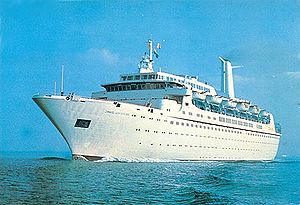MV Cunard Ambassador
 Cunard Ambassador | |
| Career | |
|---|---|
| Name: | Cunard Ambassador |
| Owner: | Cunard Line |
| Route: |
New York to Bermuda San Juan to other Caribbean ports Vancouver to Alaska |
| Builder: | Rotterdamsche Droogdok Maatschappij |
| Yard number: | 666 |
| Launched: | 16 March 1972 |
| Completed: | October 1972 |
| Fate: | Sold to C. Clausen after an onboard fire 12 September 1974 and converted to a livestock carrier. |
| Career | |
| Name: | Linda Clausen |
| Owner: | C. Clausen D/S A/S, København |
| Acquired: | 1975 |
| Refit: | Converted to a livestock carrier in 1975 |
| Fate: | Sold to Lembu Shipping Corporation of Panama |
| Career | |
| Name: | Procyon |
| Owner: | Lembu Shipping Corporation of Panama |
| Acquired: | 1980 |
| Fate: | Sold to Qatar Transport & Marine Services of Doha |
| Career | |
| Name: | Raslan |
| Owner: | Qatar Transport & Marine Services of Doha |
| Acquired: | 1983 |
| Fate: | Sold for scrap after a fire on 3 July 1983. Arrived in Kaohsiung, Taiwan for scapping on 7 September 1984. |
| General characteristics | |
| Class and type: | Cruise ship |
| Tonnage: | 14,155 gross tons |
| Length: | 484 feet (148 m) long |
| Beam: | 71 feet (22 m) |
| Decks: | 7 |
| Installed power: | Diesel powered engines |
| Propulsion: | Two propellers |
| Speed: | 20.5 knots (38.0 km/h) |
| Capacity: | 806 all-one-class passengers |
MV Cunard Ambassador was a cruise ship intended for the use of a company by the name of Overseas National Airways which was a charter airline. Along with this ship, Overseas National Airways planned seven other ships as well. At the same time, the well known Cunard Line saw the cruise market as a positive investment in the early 1960’s. How they were planning for this however was very difficult. Because of the mass popularity with cheaper and faster airplanes, this spelled the doom for transatlantic ships which was the only way of transportation over water for years. Now these services were gone and Cunard had to enter the cruise market, or face financial bankruptcy, like many other passenger lines had done before.
Contents
Construction
Built by Rotterdamsche Droogdok Maatschappij, Rotterdam, the Netherlands, 1972. 14,155 gross tons; 484 feet (148 m) long; 71 feet (22 m) wide. Diesel powered engines turning two propellers. Service speed 20.5 knots (38.0 km/h). 806 all-one-class passengers.
Ship history
A new ship for a new era
Because of the vast amount of money being put into this project with so many ships, Overseas National Airways soon ran into financial troubles, and had to abort their project. Cunard saw the opportunity and quickly took over the project. The eight cruise ships were soon reduced to only two. Cunard christened the two new ships the Cunard Adventurer of 1971 and Cunard Ambassador of 1972. Cunard Ambassador along with her twin sister, didn’t last for very long.
Both ships were intended for seven-day cruises. Some of these cruises included New York to Bermuda, San Juan to other Caribbean ports, and Vancouver to Alaska during the summer seasons.
Disaster 1
The Cunard Ambassador, along with the Cunard Adventurer, were actually less successful than intended. Unlike the Cunard Adventurer, which was shortly sold to become the Sunward II and later the Triton, the Cunard Ambassador was pulled out of Cunard service on September 12, 1974 after a fire on a positioning trip. There were no passengers on this trip, and had no fatalities involving the crew. After being towed to Key West, she was declared a total loss.
Although the Cunard line declared her a total loss, the Danish didn’t think so. She was purchased as a gutted hull, and was refitted to become the Danish sheep carrier, Linda Clausen later the same year. After serving as the Linda Clausen for about six years, she was transferred again. In 1980, the Linda Clausen became the Procyn, and then in 1983, she became the Raslan.
Disaster 2
In 1983, only a year after being rechristened Raslan, she suffered another devastating fire. This time, it happened in the Indian Ocean and the former Cunard Ambassador was beyond economic repair. After only thirteen years of service, two of which were with Cunard, she was sold to Taiwanese ship breakers and was later scrapped.
Influence
Shortly after the selling of the Cunard Adventurer and the burning of the Cunard Ambassador, Cunard planned two new ships, the Cunard Countess and the Cunard Conquest, later changed to Cunard Princess. Incorporated in these new designs were many features of those on the previous “failures” of the Adventurer and Ambassador. A similar sleek profile, a similar sleek angular funnel, and the same white hull were incorporated into the design.
References
| 50x40px | This article includes a list of references, related reading or external links, but its sources remain unclear because it lacks inline citations. Please improve this article by introducing more precise citations where appropriate. (May 2009) |
- “Picture History of the Queen Mary and Queen Elizabeth”, William H. Miller Jr., Dover Publications Inc., 2004
- “Picture History of the Cunard Line 1840 – 1990”, Frank O. Braynard and William H. Miller Jr., Dover Publications Inc., 1990
- “Doomed Ships; Great Ocean Liner Disasters”, William H. Miller Jr., Dover Publications Inc., 2006
External links
- ""7208144" (Cunard Ambassador)" (subscription required). Miramar Ship Index. R.B. Haworth. http://www.miramarshipindex.org.nz. Retrieved 2009-08-09.
- Cunard Ambassador
- Cunard Heritage - Ambassador
- Cunard Ambassador (1972)
